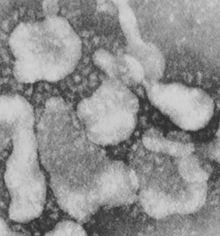David Tyrrell (physician)
David Arthur John Tyrrell CBE FRS (1925–2005) was a British virologist. He was the director of the Common Cold Unit, which investigated viruses. He and June Almeida are credited with publishing the first picture of a coronavirus.
David Tyrrell | |
|---|---|
| Born | David Arthur John Tyrrell 19 June 1925 |
| Died | 2 May 2005 (aged 79) |
| Nationality | United Kingdom |
| Alma mater | University of Sheffield |
| Scientific career | |
| Doctoral students | Wendy Barclay[1] |
Life
Born 19 June 1925, he studied medicine at the University of Sheffield, then worked at the Medical Research Council's Common Cold Unit from 1957, becoming its Director from 1982.
After June Almeida produced the first images of the rubella virus using immune-electronmicroscopy,[3] Tyrrell and Almeida worked on characterising a new type of viruses, now called coronaviruses.[4]
He retired from the Cold Unit in 1990[5] and subsequently carried out research at the Centre for Applied Microbiology and Research at Porton Down, where he also worked on his scientific autobiography, Cold Wars.[6] He died on 2 May 2005.[6]
Awards and honours
He was elected a Fellow of the Royal Society in 1970,[6] and was appointed Commander of the Order of British Empire (CBE) in 1980.[6] He held honorary degrees from the University of Sheffield (1979) and the University of Southampton (1990), and received the Stewart Prize (1977), the Ambuj Nath Bose prize (1983), and the Conway Evans Prize (1986).[6]
References
- Barclay, Wendy S. (1988). The humoral immune response to rhinovirus infection. copac.jisc.ac.uk (PhD thesis). University of Reading. OCLC 499917328. EThOS uk.bl.ethos.383380.
- Almeida, June D.; Tyrrell, D. A. J. (1967). "The Morphology of Three Previously Uncharacterized Human Respiratory Viruses that Grow in Organ Culture". Journal of General Virology,. 1 (2): 175–178. doi:10.1099/0022-1317-1-2-175. ISSN 0022-1317.CS1 maint: extra punctuation (link)
- Paterson, Andrew (2017). Brilliant! Scottish inventors, innovators, scientists and engineers who changed the world. London: Austin Macauley. p. 577. ISBN 9781786294357.
- Booss, John; August, Marilyn J (2013). To catch a virus. Washington, DC: ASM Press. p. 217. ISBN 1-55581-507-3.
- Tilli Tansey; Peter Catterall; Sonia V Willhoft; Daphne Christie; Lois Reynolds, eds. (1997), Technology Transfer in Britain: The Case of Monoclonal Antibodies; Self and Non-Self: A History of Autoimmunity; Endogenous Opiates; The Committee on Safety of Drugs, Wellcome Witnesses to Contemporary Medicine, History of Modern Biomedicine Research Group, ISBN 978-1-869835-79-8, Wikidata Q29581528
- Kerr, J. R.; Taylor-Robinson, D. (2007). "David Arthur John Tyrrell. 19 June 1925 – 2 May 2005: Elected FRS 1970". Biographical Memoirs of Fellows of the Royal Society. Royal Society. 53 (0): 349–363. doi:10.1098/rsbm.2007.0014. ISSN 0080-4606.
